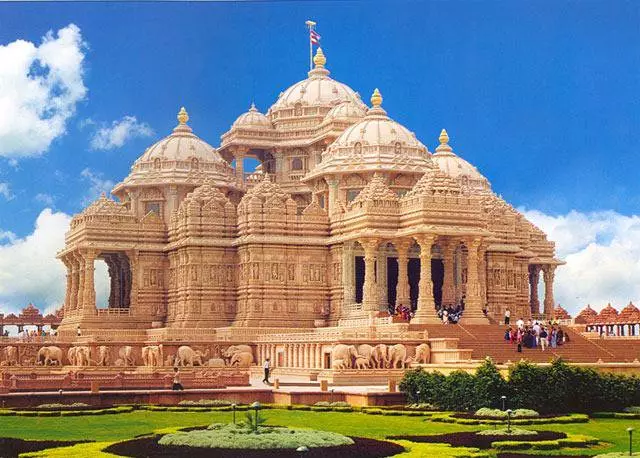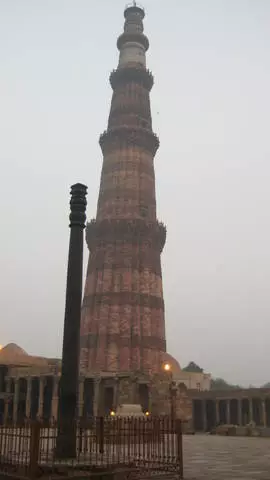The first forty from which my acquaintance with the Indian architecture began, was Purana Kila, from which, in fact, there is little, which remains. To date, Purana-Kila survived the walls, a mosque in the Afghan style, a library and three gates: a large gate (the main entrance), through which we entered, Humayun's gate (used as a background for 3D light-sound laser shows) and the Forbidden Gate (not Used, closed), close to which not to approach, the passage is blocked, as I understood, all sorts of offices are located there.
The second forty, shook to the depths of the soul, became Lal-Kila, or a red fort, the creation of a rushing architectural genius of Shazhana. Lal-Kila is an octagon, surrounded by the moat, with palaces, harem, pavilions, parks. On the northern and southern walls, the famous inscription on Farsi "If there is where he is heaven on Earth, then he is here, only here" (initially the inscription was made in gold, Shadjhan was generally addicted to the scribe of gold on the stone, because in the Taj Mahahal the same Ambitions are traced). The good half of the fort is closed - on the restoration or just starts to collapse? .. I think the second option, because we managed to still look into the Shish-Mahal (mirror palace), locked on a rusty barn castle (unique marble simply drilled and screwed to Him this nightmare, who took and rusted). Lifens up, but former greatness is still preserved. A great impression in the fort produced inlay marble with precious and semi-precious stones - these flowers in the style of Shazhana, I managed to consider to the smallest detail, approaching closely.
Now I Lal Kila are restless cheerful chipmunks. In Fort, all sorts of shops and souvenir shops are also located.
Lotus Temple - Bahais's Prayer House, Bahai Temple - is a business card Delhi. Twenty-seven concrete petals lined with white marble tiles rise to a height of 35 meters and are surrounded by nine small ponds. If you look at the temple from above, it looks like a lotus flower with a diameter of about 70 meters growing in a pond.

The temple was built only in 1986 for donations and along with the park occupies a huge territory. The temple is great. Inside the temple of the rows of stone benches. No painting, no inner thread, which in itself is very surprising and unusual for the Indian temple. The girl who has developed hands in Namaste - this gesture in all eastern countries is the meaning of "tending before your divine essence" - signs make it clear that in the temple it is necessary to observe the utter silence. People of different nationalities and religions are sitting with closed eyes: some pray to their gods, others meditate, others just think about life or a buzz catch. One-time in the temple there may be 1,300 people. Good place. If the soul has not yet frightened, not petrified, she will not remain indifferent.
No one leaves indifferent the majestic Akshardham - a modern temple complex from pink and white marble on the shore of Yamuna in East Delhi. Pink color symbolizes the love of God, and the white is the world and absolute purity. Achshardham is a unique monument of Indian culture, built for 5 years by the followers of the teachings (sects) of Svinatelayans and opened in 2005. In construction, 7 thousand masters took part, the construction of the complex was spent about 500 million $, collected due to voluntary donations. Akskhardam entered the Guinness Book of Records as the most ambitious Hindu temple in the world. During construction, marble and red sandstone were used, steel and concrete were excluded. "The residence of God, which cannot be displaced" spread over 12 hectares. The memorial from three sides surrounds the lake, which brought water from 151 reservoirs from all over India. The 42-meter Akshardham is crowned with nine luxury domes and twenty-four-edged turrets-shahkar, in the decoration of the temple of 234 carved columns, 20 thousand figures (sculptures) of deities, animals, dancers, around the perimeter of 148 elephants; The height of the statue in the center of the temple 3m. I can't stand the abundance of numbers, but in this case it is a need for you to make it more accurate to imagine the greatness and sizes of the temple. Of course, Acharadham produces a very strong impression, especially if you only at the beginning of our way and have not managed to enjoy the magnificence of Jainic temples, one only complex carving on columns, walls and ceiling of something! The complex is too little known, because there is a categorical ban on the photo and video inside it. Acharadham is more like a memorial, a gigantic magnificent museum with religious theme.

Last, what I want to tell, these are two big and focusing mosque in Delhi Jama Masjid and Kutub Minar.
The majestic Jama Masjid (Cathedral / Friday Mosque) is the main mosque of the old Delhi, one of the largest mosques in the world. For believers, this mosque is of particular importance, because the invaluable relics of the Muslim world are kept here: a copy of the Koran written on the skin of a deer, the sneakers of the Prophet Mohammed, the imprint of his feet in the stone, Sura Koran, written allegedly under his dictation, reddish hair from his beard and fragments Tombstones, once stood over his grave. The strict energy of this place is felt while you rising 35 steps leading to the main entrance facing Lal Kila.
Kutub Minar / Kutub-Minar is a unique monument of medieval Indo-Islamic architecture. The highest tower in India, the world's highest brick minaret, which is a UNESCO World Heritage Site. In the Middle Ages, Kutub-Minar was considered one of the miracles of the world. The creators of Kutb Minar were undoubtedly ingenious mathematicians, if they produced so chums calculations. They possess the rarest artistic taste, so the tower still amazing the imagination of anyone, without leaving a single chance of indifference.
Well, the last monument of the Kutub-Minar complex, which I want to tell, is the mysterious iron column of Chandragoupe. Its riddle is that it consists of 99.72% of iron and stands already at this place from one and a half to three thousand years (information is very contradictory), and there is no rust.

I will not tell anything more, as we are in a span with a modern part of Delhi: the whole center was blocked for several days due to the preparation for the celebration of Independence Day and the parade rehearsal. So we did not see Rajpath nor the National Museum, nor the Triumphal Arch called India's Gate with Eternal Fire.
